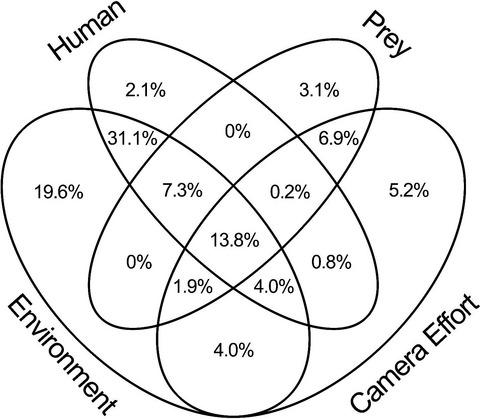当前位置:
X-MOL 学术
›
Anim. Conserv.
›
论文详情
Our official English website, www.x-mol.net, welcomes your
feedback! (Note: you will need to create a separate account there.)
Environmental factors, human presence and prey interact to explain patterns of tiger presence in Eastern Thailand
Animal Conservation ( IF 2.8 ) Pub Date : 2020-08-26 , DOI: 10.1111/acv.12631 E. Ash 1, 2 , Ż. Kaszta 1 , A. Noochdumrong 3 , T. Redford 2 , D. W. Macdonald 1
Animal Conservation ( IF 2.8 ) Pub Date : 2020-08-26 , DOI: 10.1111/acv.12631 E. Ash 1, 2 , Ż. Kaszta 1 , A. Noochdumrong 3 , T. Redford 2 , D. W. Macdonald 1
Affiliation

|
Thailand is one of the last strongholds for tigers Panthera tigris in mainland Southeast Asia. Evidence suggests heterogeneity in tiger presence in a globally important landscape in Eastern Thailand is potentially influenced by a complex interaction of prey, human presence and environmental conditions. Understanding these dynamics is of considerable importance for the conservation of tigers both in this landscape and elsewhere in their range. In this study, we examine which factors, among prey, human presence and environmental characteristics, best explain tiger presence in the Dong Phayayen–Khao Yai Forest Complex (DPKY). We collated survey data from 56,214 camera trap nights and evaluated the relationship between tiger presence and a suite of five prey, 11 human presence and eight environmental variables. We then used variance partitioning to discern the degree of variance in tiger presence explained by these factors. We documented strong, positive associations with wild boar Sus scrofa presence and prey richness, and strong, negative associations with human settlement density, public roads and presence of poachers. Environmental characteristics explained a greater relative proportion of variance (19.6%) in tiger presence than prey covariates alone (3.1%), particularly confounded with human presence (31.1%). This suggests that environmental variables, especially when accompanied by anthropogenic factors, could be used to model potential tiger occurrence where other data may be lacking. Our approach may be helpful in providing guidance for prioritizing habitat, evaluating the effect of human presence and identifying key prey to provide a foundation for tiger protection and recovery.
中文翻译:

环境因素,人类的存在和猎物的相互作用解释了泰国东部老虎的存在方式
泰国是老虎的最后据点之一学名:Panthera tigris在东南亚大陆。有证据表明,在泰国东部具有全球重要性的景观中,老虎的异质性可能受到猎物,人类生存和环境条件之间复杂相互作用的影响。理解这些动态变化对于保护这一景观及其范围内的其他老虎都具有十分重要的意义。在这项研究中,我们研究了在猎物,人类的存在和环境特征中,哪些因素最能解释东帕耶恩-考艾森林综合体(DPKY)中老虎的存在。我们整理了来自56,214个相机陷阱之夜的调查数据,并评估了老虎的存在与一组5个猎物,11个人类存在和8个环境变量之间的关系。然后,我们使用方差分区来识别这些因素所解释的老虎存在方差的程度。我们记录了与野猪的强而积极的联系Sus scrofa的存在和猎物的丰富性以及与人类住区密度,公共道路和偷猎者的存在的强烈消极关联。环境特征说明,与单独的猎物协变量(3.1%)相比,老虎存在下差异的相对比例(19.6%)更大,尤其是与人类存在时的混杂比例(31.1%)相比。这表明环境变量,尤其是在伴随人为因素的情况下,可以用于模拟可能缺乏其他数据的潜在老虎发生情况。我们的方法可能有助于为优先考虑栖息地,评估人类存在的影响以及确定关键猎物提供指导,从而为保护和恢复老虎提供基础。
更新日期:2020-08-26
中文翻译:

环境因素,人类的存在和猎物的相互作用解释了泰国东部老虎的存在方式
泰国是老虎的最后据点之一学名:Panthera tigris在东南亚大陆。有证据表明,在泰国东部具有全球重要性的景观中,老虎的异质性可能受到猎物,人类生存和环境条件之间复杂相互作用的影响。理解这些动态变化对于保护这一景观及其范围内的其他老虎都具有十分重要的意义。在这项研究中,我们研究了在猎物,人类的存在和环境特征中,哪些因素最能解释东帕耶恩-考艾森林综合体(DPKY)中老虎的存在。我们整理了来自56,214个相机陷阱之夜的调查数据,并评估了老虎的存在与一组5个猎物,11个人类存在和8个环境变量之间的关系。然后,我们使用方差分区来识别这些因素所解释的老虎存在方差的程度。我们记录了与野猪的强而积极的联系Sus scrofa的存在和猎物的丰富性以及与人类住区密度,公共道路和偷猎者的存在的强烈消极关联。环境特征说明,与单独的猎物协变量(3.1%)相比,老虎存在下差异的相对比例(19.6%)更大,尤其是与人类存在时的混杂比例(31.1%)相比。这表明环境变量,尤其是在伴随人为因素的情况下,可以用于模拟可能缺乏其他数据的潜在老虎发生情况。我们的方法可能有助于为优先考虑栖息地,评估人类存在的影响以及确定关键猎物提供指导,从而为保护和恢复老虎提供基础。







































 京公网安备 11010802027423号
京公网安备 11010802027423号